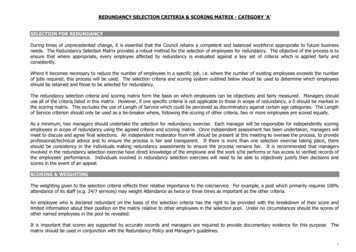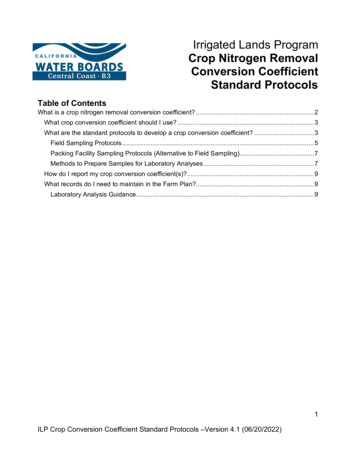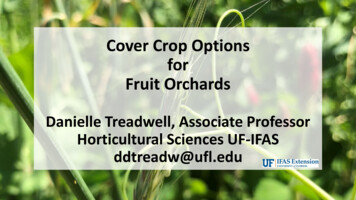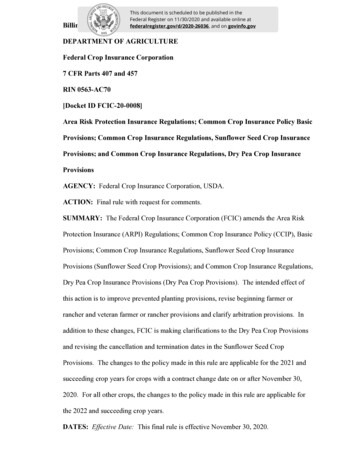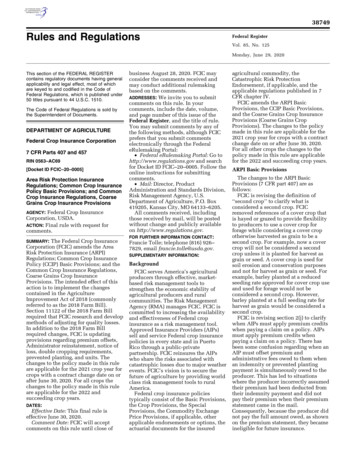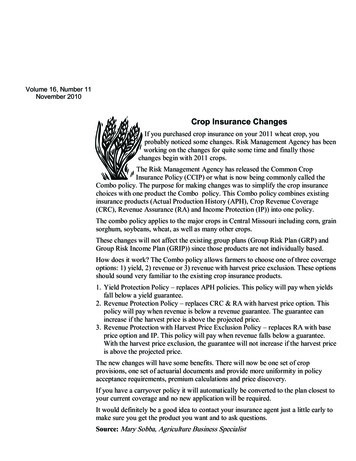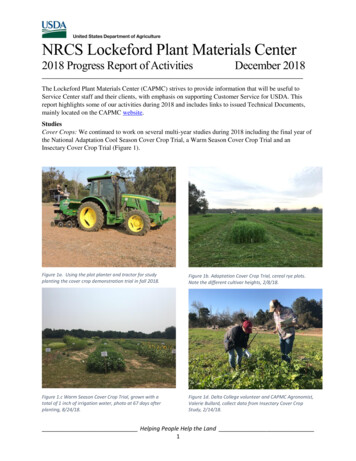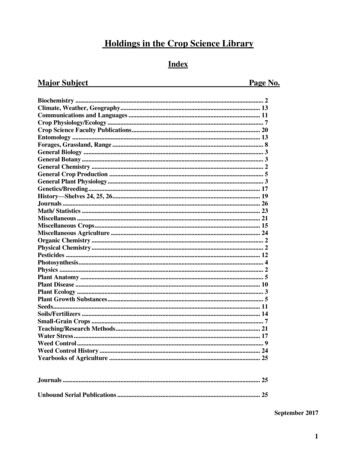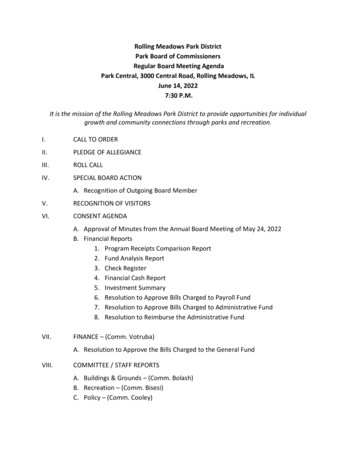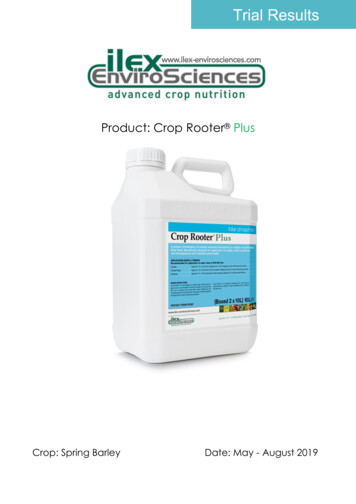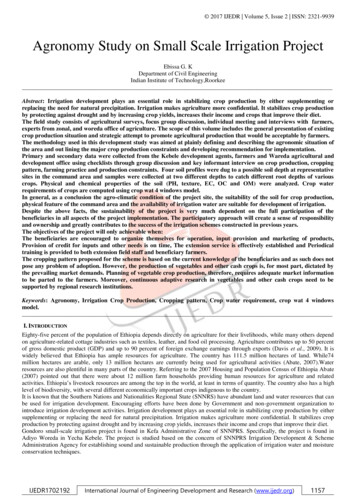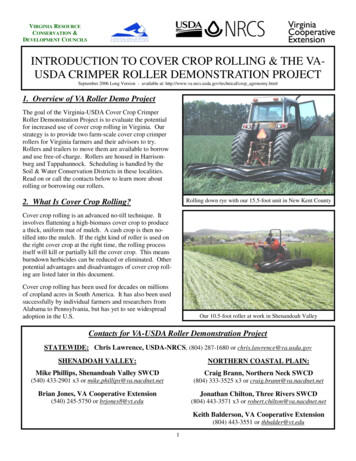
Transcription
VIRGINIA RESOURCECONSERVATION &DEVELOPMENT COUNCILSINTRODUCTION TO COVER CROP ROLLING & THE VAUSDA CRIMPER ROLLER DEMONSTRATION PROJECTSeptember 2006 Long Version - available at: http://www.va.nrcs.usda.gov/technical/crop agronomy.html1. Overview of VA Roller Demo ProjectThe goal of the Virginia-USDA Cover Crop CrimperRoller Demonstration Project is to evaluate the potentialfor increased use of cover crop rolling in Virginia. Ourstrategy is to provide two farm-scale cover crop crimperrollers for Virginia farmers and their advisors to try.Rollers and trailers to move them are available to borrowand use free-of-charge. Rollers are housed in Harrisonburg and Tappahannock. Scheduling is handled by theSoil & Water Conservation Districts in these localities.Read on or call the contacts below to learn more aboutrolling or borrowing our rollers.Rolling down rye with our 15.5-foot unit in New Kent County2. What Is Cover Crop Rolling?Cover crop rolling is an advanced no-till technique. Itinvolves flattening a high-biomass cover crop to producea thick, uniform mat of mulch. A cash crop is then notilled into the mulch. If the right kind of roller is used onthe right cover crop at the right time, the rolling processitself will kill or partially kill the cover crop. This meansburndown herbicides can be reduced or eliminated. Otherpotential advantages and disadvantages of cover crop rolling are listed later in this document.Cover crop rolling has been used for decades on millionsof cropland acres in South America. It has also been usedsuccessfully by individual farmers and researchers fromAlabama to Pennsylvania, but has yet to see widespreadadoption in the U.S.Our 10.5-foot roller at work in Shenandoah ValleyContacts for VA-USDA Roller Demonstration ProjectSTATEWIDE: Chris Lawrence, USDA-NRCS, (804) 287-1680 or chris.lawrence@va.usda.govSHENADOAH VALLEY:NORTHERN COASTAL PLAIN:Mike Phillips, Shenandoah Valley SWCDCraig Brann, Northern Neck SWCD(540) 433-2901 x3 or mike.phillips@va.nacdnet.net(804) 333-3525 x3 or craig.brann@va.nacdnet.netBrian Jones, VA Cooperative ExtensionJonathan Chilton, Three Rivers SWCD(540) 245-5750 or brjones8@vt.edu(804) 443-3571 x3 or robert.chilton@va.nacdnet.netKeith Balderson, VA Cooperative Extension(804) 443-3551 or thbalder@vt.edu1
3. Who Should Consider Rolling?Cover crop rolling is not for everyone. To help you decide if it might work for you, we’ve provided the following profiles of Virginia growers who we think are mostlikely to benefit:A. Traditional Field Crop ProducersIf you are a traditional field crop producer (corn, soybeans, cotton, etc.), cover crop rolling may be for you ifmost or all of the following are true:1. You are an experienced no-tiller or you plan to become one;2. You grow later-planted crops such as full-seasonsoybeans or cotton, or you might consider delayingthe seeding of earlier-planted crops like corn;3. You grow cover crops, you are willing to kill themlate, and you are willing to manage them for highbiomass production;4. You have a strong interest in maximizing soil organic matter and soil quality on your land.Organic soybeans no-tilled into rolled rye, King & Queen Co.No-herbicide no-till!B. Vegetable and Specialty Crop ProducersMany vegetable and specialty crop producers should takea close look at cover crop rolling, whether or not theyhave ever no-tilled a crop before. For example, there is aspecial place for rolling ahead of crops like no-till pumpkins because of the clear production advantages of keeping fruit from touching soil all summer.C. Organic ProducersCover crop rolling should be of great interest to all organic (pesticide-free) producers, because it is opens thedoor to herbicide-free no-till and the cost-savings andsoil quality benefits associated with reduced soil disturbance.Pumpkins no-tilled into rolled rye, New Kent Co.4. Which Cover Crops Roll Best?A. Many SpeciesRolling is for killing annual cover crops. It is most oftenused on winter annual cereal cover crops like rye. InVirginia, tall cereal rye appears to be much better suitedto rolling than barley and wheat. This is logical becausemost barley and wheat has been bred for standability andshort straw. Winter annual grass/legume mixes like rye/hairy vetch or barley/crimson clover also work well.B. High YieldsRolling is for killing high-yield cover crops. Even if theright species is rolled with the right tool at the rightgrowth stage, the full benefit of rolling will not be seenunless there is a lot of cover crop biomass. Therefore,Our special trailers can lay flat on the ground if needed, sorollers can be loaded and unloaded without lifting.2
you may need to spend more time and money growing acover crop for rolling than you would growing a typicalcover crop. For example, if you are trying to grow ahigh-biomass rye cover crop for rolling on a sandy Virginia Coastal Plain soil with low nitrogen (N) carryoverfrom the previous crop, a minimum spring application of30 lb/ac of N will probably be needed to achieve the desired biomass. Remember, we expect this investment inyour soil to pay you dividends in the long run, as furtherdiscussed below.d. Better environment for some beneficial insects and organisms such as earthworms;e. No bare soil for cleaner picking and products(e.g. pumpkins).7. Short-Term Disadvantages of Rolling1. Higher cover crop production costs:To maximize the advantages of rolling, cover cropbiomass should be maximized. This usually requiresmore management (timely seeding, etc.) and inputs(more seed, better seed, fertilization, etc.) than mostfarmers typically devote to cover crops.C. Uniform StandsRolling is for killing uniform stands of high-biomasscover crops. Uniform stands are important for uniformmulch thickness, which can have key planting and weedcontrol implications.2. Late cover crop kill dateSome examples of disadvantages of killing a covercrop late include:a. Delayed cash crop planting date;b. Risk of the cover crop setting and droppingviable seed.5. Which Cash Crops Work Best with Rolling?3. Drying out soil profile ahead of cash crop planting:Heavy water use by a cover crop can dry out the soilahead of cash crop planting. On certain soils in certain years, this can be a clear disadvantage.Cover crop rolling can be and has been used successfullyahead of almost any crop that can be no-tilled, either bydirect-seeding or no-till transplanting. However, rollingfits best ahead of later-planted cash crops in Virginiasuch as full-season soybeans, cotton, and vegetables.4. Negative mulch effects:Some possible disadvantages of no-tilling into a verythick mat of mulch:a. Problems getting seed-to-soil contact;b. Slower soil warming, germination, and seedling growth in a cool spring;c. Better environment for some pests organisms such as slugs, cutworms, etc.;d. Possible early-season N tie-ups and deficiencies when a grass cash crop like corn is notilled into a mulch of very mature, high C:Nratio grass cover like rye.6. Short-Term Advantages of Rolling1. Maximum cover crop biomass:Rolling works best when a cover crop is killed lateand when it is managed for high biomass. Therefore,the practice is associated with maximizing theamount of above- and below-ground organic matterreturned to the soil by a cover crop. If the cover cropincludes a legume, N carryover to the next crop willbe also maximized.2. Burndown herbicide reduction:When done properly, rolling can allow for reductionor elimination of burndown herbicides (see Page 5).3. Drying out soil profile ahead of cash crop planting:Heavy water use by a cover crop can dry out the soilahead of cash crop planting. On certain soils in certain years, this can be a production advantage.4. Positive mulch effects:The following benefits can be expected when a cashcrop is no-tilled into a thick, uniform mat of mulch:a. Better weed control, especially early ingrowing season;b. Cooler soil and improved moisture retentionin mid-summer;c. Maximum soil protection from raindrop impact and erosion;Straight-bar crimper roller: a bumpy ride at 6 mph!3
Early boot-stage rye.Good biomass but TOO EARLY to roll.(11 April 2006, New Kent Co., VA)8. Long-Term ConsiderationsWhen evaluated on a single-year basis (in the absence ofcost share), the economics of growing a cover crop areoften break-even or worse. But when cover crops areconsistently grown over a period of years, their cumulative soil organic matter and nutrient cycling benefits aremuch more likely to translate into increased profit. Thisis especially true if cover cropping is used in conjunctionwith continuous no-till and crop rotation. The manypositive interactions between cover cropping, continuousno-till, and crop rotation can’t be overemphasized. Weare starting to understand that combining these practicesover a period of five to 10 years offers a real opportunityto improve long-term profitability for Virginia farmers.This is in part due to no-till fuel and time savings and inpart due to production efficiencies that accumulate assoil quality improves. Adopting these practices alsomeans major environmental and conservation benefits.Rye at pollination stage. Great biomass and ready to roll.Note same shovel as in picture above.(10 May 2005, Rockingham Co., VA)Where does rolling fit in? Managing cover crops forhigh biomass production simply accelerates the longterm process of soil quality improvement describedabove. Once a farmer decides he wants to speed up thesoil organic matter buildup that occurs with continuousno-till, then high biomass cover crops make sense. Andonce a farmer decides that he wants to grow high biomass cover crops, then rolling makes sense. This is whyrolling is expected to have significant appeal amongfarmers who are committed to no-till and to increasingtheir soil organic matter levels and soil quality.9. Crimping vs. RollingCrimping involves rolling down a cover crop with a special tool that not only flattens the crop, but also repeatedly crushes (but does not cut) cover crop stems. On ourmachines, the blunt edges of three-inch tall metal barswelded to the roller drum do the crimping (see picture onnext page). Crimping further damages the cover cropand increases the likelihood it will stay down and dieafter rolling. Therefore, using a crimper becomes moreimportant if you are trying to kill a cover crop with noherbicide.Rye at grain-fill stage, perfect for herbicide-free rolling. Thinkthere’s enough biomass here?(3 May 2005, Southampton Co., VA)If a standing cover crop is killed with a full rate of herbicide, then almost any device (roller without crimpingbars, cultipacker, etc.) can be used to roll down the crop.Some farmers say they are able to cut herbicide rates onflattended mature cover crops even when a speciallydesigned crimper has not been used. But if your goal isto minimize or eliminate burndown herbicides, youshould try a specially-designed crimper roller such asone of our demonstration units.4
cash crop seeding, but some growers roll immediately before or even after no-tilling their cash crop;5. If you crimp/roll with reduced or no burndown herbicide, it seems wise to allow some time to see ifyour cover crop dies before no-tilling your cash crop.The exception to this is if you have the option ofcleaning up cover crop regrowth with selective herbicides once the cash crop is growing;6. When rolling is used in conjunction with systemic(Roundup-type) herbicides, spraying has been successfully done before, during, and after rolling;7. In 100% herbicide-free systems, be prepared to makeadditional passes with roller or flail mower in casethe first crimping does not fully kill the cover crop.Curved crimping bars on our rollers make for a smooth ride.10. Features of Our VA-USDA CrimperRollersB. Timing: Winter Cereal Cover CropsHere are additional suggestions for rolling winter cerealcover crops with our VA-USDA crimper rollers. It maybe possible to cut herbicide rates even lower than described below, but we’ll need to evaluate results of onfarm tests before we can say more.Our two demonstration cover crop crimper rollers werecustom built in Dayton, VA. Their design is based inlarge part on published specifications for a smooth rolling cover crop crimper roller developed by the USDAAgricultural Research Service (ARS) Soil Dynamics Labin Auburn, AL. Their most important features are:1. Do not consider rolling cereals with our units unlessseedheads are visible across the entire field;1. Maximum crimping action:Our rollers are built heavy to maximize crimping andminimize need for burndown herbicides. They canalso be filled with water for added weight.2. If a high-biomass cereal crop is crimped with ourunits around the time of flowering/pollination, it willlikely stay flat and die if burndown herbicides arereduced (¾ to ¼ of normal rates). Be ready to getcovered in pollen if you roll at flowering.3. If a high-biomass cereal crop is crimped with ourunits during the grain fill period, it will likely stayflat and die even if burndown herbicides are significantly reduced or eliminated (½ of normal rates to noherbicide). If carryover of viable cover crop seed isa problem for you, do not wait until later grain fillstages to roll.4. If you delay crimping with our units until the softdough stage, it is very likely the crop will stay flatand die without the use of herbicides.2. Smooth rolling action:Our crimping bars are curved around the roller cylinder in order to eliminate the excessive vibration thatoccurs at high operating speed with a traditionalstraight crimping bar design.11. When Should I Roll?Timing of cover crop rolling is a key issue. There aremany general principles and tradeoffs for you to consider. As our understanding of rolling improves, we willupdate the guidelines offered below:A. Timing: General1. There is typically very little value in crimping/rollingannual cover crops until they have started the reproductive phase of their life cycle (bloom stage);2. The more mature the cover crop is when it iscrimped/rolled, the less supplemental burndown herbicide will be needed;3. If you allow the cover crop to mature too much before crimping, it will produce and drop viable seed.Depending on your system, this may be a very important reason not to wait too long before crimping;4. Our recommendation is to roll a few weeks prior toHere the planter “hairpinned” rolled residue into the plantingslot and the seed never touched soil. Sharpen your coulters!5
manage your cover crop for maximum biomass anduniformity much as you would a cash crop.12. How Should I Roll?More advice for maximizing success with our rollers:13. Suggestions For On-Farm Tests WithOur Rollers1. Match roller and planter width:Many growers say that the best option is to roll downthe cover crop in the same direction/pattern as youexpect to plant the cash crop. For this reason, aroller width that exactly matches the width of yourno-till planter or drill is best.1. We encourage farmers to try with our rollers on limited acreage. This is new technology and disasterscan happen.2. We encourage farmers to use our rollers to set upsimple strip or split-field test plots rather than to rolldown entire fields in a uniform manner. Both approaches are acceptable, but we will all probablylearn more from side-by-side comparisons than fromrolling entire fields.3. On-farm tests need not be complicated. They can beas simple as splitting a field or rolling down one stripin a field and then taking a little extra time to keeptrack of crop progress. Hard data and yield measurements are ideal, but farmer observations alone areextremely valuable to us. For help with setting up ormonitoring on-farm cover crop rolling tests, call thecontacts listed on Page 1.4. Some examples of good side-by-side comparisons:a. Cover crop sprayed early vs. rolled downlate;b. Cover crop harvested for hay or silage vs.rolled down late;c. Cover crop rolled down at different growthstages with the same amount of herbicideused;d. Cover crop rolled down at the same growthstage with different amounts of herbicideused.In all of the above plots, the cash crop could be notilled into both treatments on the same day and managed the same way throughout the season.2. Run parallel:If roller and planter widths don’t match up, manygrowers find they are able to still plant effectively aslong as their cash crop rows run more or less parallelto the direction of rolling. Some prefer to plant at aslight angle with respect to the direction of rolling.In both cases, no-till seed furrow openers and otherground- or residue-engaging hardware on the planting machine are typically moving aside most of theheavy residue rather than cutting through it.3. Don’t run perpendicular (unless your planter is up tothe task!):Most growers agree that planting perpendicular tothe direction of rolling is not a good idea. This requires cutting through large quantities of residue andincreases the likelihood of hairpinning, poor seed-tosoil contact, and bad stands.4. Look out for lodging:A real problem occurs when a high biomass grasscover crop like rye lodges or falls over on its own ina random pattern. The result is a “weave” of mulchgiving you no clear direction to plant in and variableamounts of residue to cut through as you movethrough the field. For this reason, minimize the riskof lodging by not over-fertilizing rye or other susceptible cover crops with N. If you are concernedthat a crop may lodge before the right stage for rolling, consider rolling early to establish a pattern, eventhough you expect it to stand back up. Then terminate the crop with another pass at the right time.14. VA –USDA Roller Project PartnersThanks to all of the following organizations for makingthis project possible:1. Northern Neck Soil & Water Conservation District2. Shenandoah Resource Conservation & Development(RC&D) Council3. Shenandoah Valley Soil & Water Conservation District4. Three Rivers Soil & Water Conservation District5. Tidewater Resource Conservation & Development(RC&D) Council6. USDA Natural Resources Conservation Service7. Virginia Cooperative Extension5. Crimp, don’t cut:Remember: the goal is to crush but not cut covercrop stems. Cut plants often regrow. If one of ourcrimpers is doing a lot of cutting, then most likelythe crop is too immature/not stemmy enough or thereis not enough total biomass.6. Manage for high biomass, uniform cover crops!A high biomass, uniform cover crop not only makesa better mulch mat — it is also much more likely tostay down and die when rolled! For this reason, werecommend that you seed, fertilize, and otherwiseThe USDA is an equal opportunity provider and employer6
Virginia, tall cereal rye appears to be much better suited to rolling than barley and wheat. This is logical because most barley and wheat has been bred for standability and short straw. Winter annual grass/legume mixes like rye/ hairy vetch or barley/crimson clover also work well. B. High Yields Rolling is for killing high-yield cover crops.
